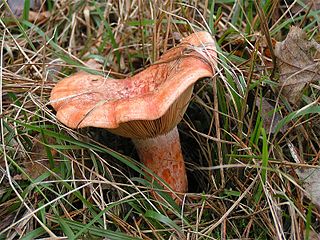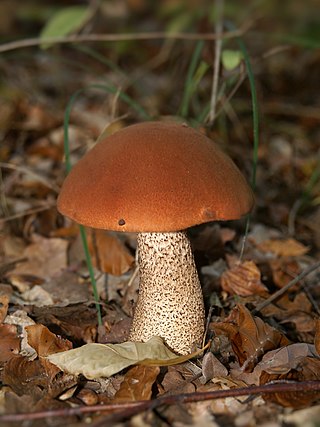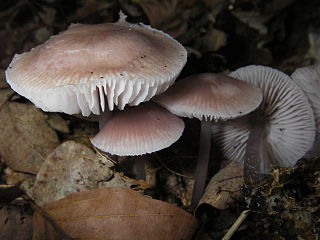
Edible mushrooms are the fleshy fruit bodies of several species of macrofungi. Edibility may be defined by criteria including the absence of poisonous effects on humans and desirable taste and aroma. Mushrooms that have a particularly desirable taste are described as "choice". Edible mushrooms are consumed for their nutritional and culinary value. Mushrooms, especially dried shiitake, are sources of umami flavor.

Pleurotus ostreatus, the oyster mushroom, oyster fungus, hiratake, or pearl oyster mushroom is a common edible mushroom. It is one of the more commonly sought wild mushrooms, though it can also be cultivated on straw and other media.

Lactarius deliciosus, commonly known as the delicious milk cap, saffron milk cap and red pine mushroom, is one of the best known members of the large milk-cap genus Lactarius in the order Russulales. It is native to Europe, but has been accidentally introduced to other countries along with pine trees, with which the fungus is symbiotic.

Clitocybe is a genus of mushrooms characterized by white, off-white, buff, cream, pink, or light-yellow spores, gills running down the stem, and pale white to brown or lilac coloration. They are primarily saprotrophic, decomposing forest ground litter. There are estimated to be around 300 species in the widespread genus.

Collybia nuda, commonly known as the blewit or wood blewit and previously described as Lepista nuda and Clitocybe nuda, is an edible mushroom native to Europe and North America. Described by Pierre Bulliard in 1790, it was also known as Tricholoma nudum for many years. It is found in both coniferous and deciduous woodlands. It is a fairly distinctive mushroom that is widely eaten. It has been cultivated in Britain, the Netherlands and France. This species was reassigned to the genus Collybia in 2023.

Blewit refers to two closely related species of edible agarics in the genus Collybia, the wood blewit and the field blewit or blue-leg.

Leccinum aurantiacum is a species of fungus in the genus Leccinum found in forests of Eurasia and North America. It has a large, characteristically red-capped fruiting body. In North America, it is sometimes referred to by the common name red-capped scaber stalk. Some uncertainties exist regarding the taxonomic classification of this species in Europe and North America. It is considered edible, but must be cooked thoroughly.

Agaricus campestris is a widely eaten gilled mushroom closely related to the cultivated A. bisporus. A. campestris is commonly known as the field mushroom or, in North America, meadow mushroom.

Collybia personata is a species of edible fungus commonly found growing in grassy areas across Europe and is morphologically related to the wood blewit Collybia nuda. This mushroom was moved to the genus Collybia in 2023.

Clitocybe nebularis or Lepista nebularis, commonly known as the clouded agaric, cloudy clitocybe, or cloud funnel, is an abundant gilled fungus which appears both in conifer-dominated forests and broad-leaved woodland in Europe and North America. Appearing in Britain from mid to late autumn, it is edible, but may cause gastrointestinal issues.

Aspropaxillus giganteus, also Leucopaxillus giganteus, commonly known as the giant leucopax or the giant funnel, is a saprobic species of fungus in the order Agaricales. As its common names imply, the fruit body, or mushroom, can become quite large—the cap reaches diameters of up to 50 cm (20 in). It has a white or pale cream cap, and is funnel-shaped when mature, with the gills running down the length of the stem. Considered by some to be a choice edible when young, this species has a cosmopolitan distribution, and is typically found growing in groups or rings in grassy pastures, roadside hedges, or woodland clearings. It has been shown to contain a bioactive compound with antibiotic properties.

Grifola frondosa is a polypore mushroom that grows at the base of trees, particularly old growth oaks or maples. It is typically found in late summer to early autumn. It is native to China, Europe, and North America.

Mycena pura, commonly known as the lilac mycena, lilac bonnet, is a species of mushroom in the family Mycenaceae. First called Agaricus prunus in 1794 by Christian Hendrik Persoon, it was assigned its current name in 1871 by German Paul Kummer. Mycena pura is known to bioaccumulate the element boron.

Clitocybe tarda is a species of mushroom. It has a brownish pink cap with a smooth surface, the flesh is thin and brittle, and the cap tastes bitter. The stalk is slender and smooth. The spore print is pinkish gray. It is unknown if the species is edible, but it does not have a pleasant taste.

Paralepista flaccida is a species of mushroom found across the Northern Hemisphere. It is known to form fairy rings.

Amanita excelsa, also known as the European false blushing amanita, is a species of agaric fungus in the family Amanitaceae. It is found in Asia, Europe, and North America, where it grows in deciduous forests.

Pholiota squarrosoides is a species of mushroom in the family Strophariaceae. It is similar to the species Pholiota squarrosa. There are differing accounts on whether the mushroom is edible.

Collybia brunneocephala, also known as the brown blewit or brownit, is a species of gilled mushroom. Previously designated Clitocybe brunneocephala, the brownit and its lavender-colored cousin the wood blewit were reassigned to the genus Collybia in 2023.

















